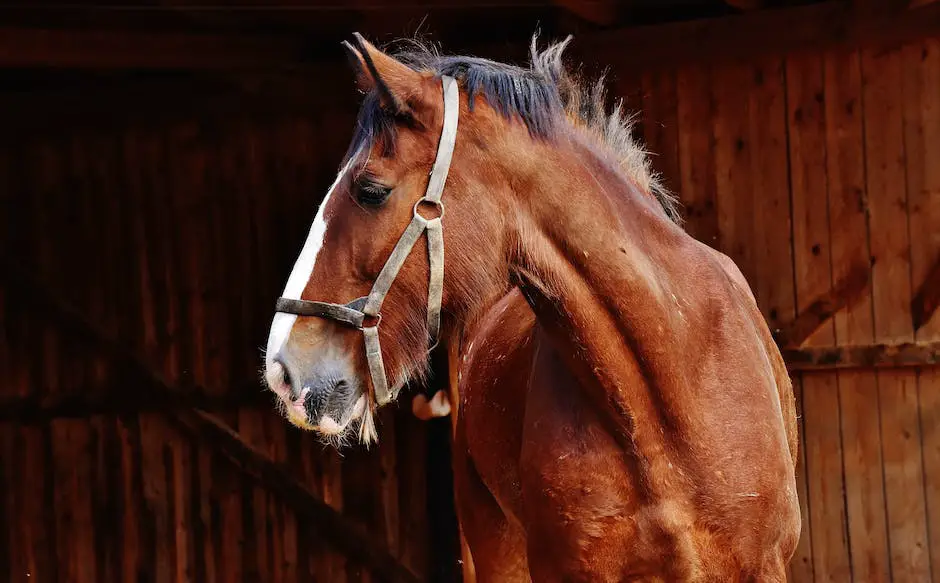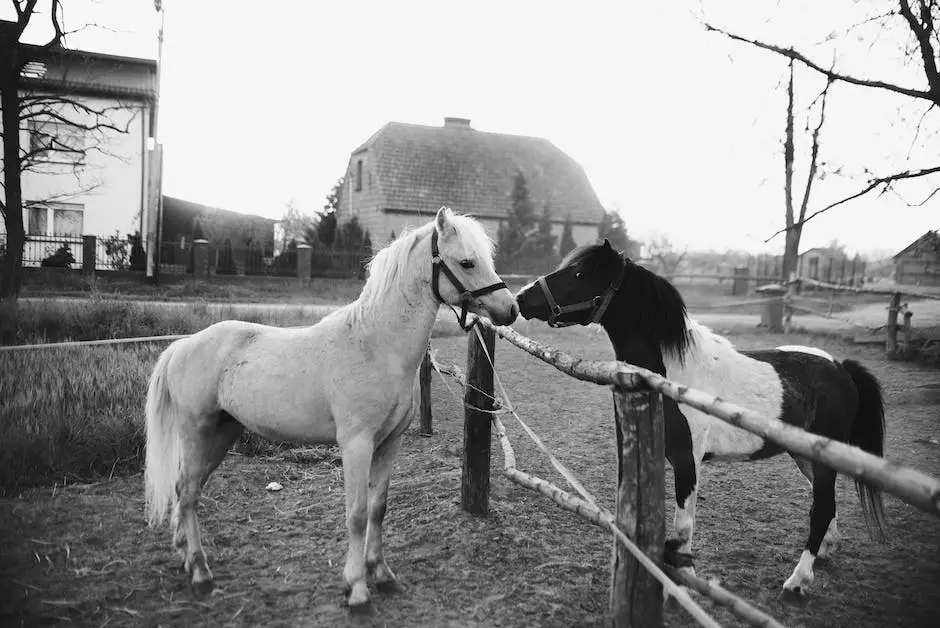When one speaks of ‘cold blooded’ in the context of horses, they are not referring to physiological similarities with reptiles, but a distinct temperament trait usually found in heavy draft horses. These gentle giants have been treasured throughout history for their calm disposition and steadfast nature. It’s a complex concept, involving an understanding of equine behavior, breeding evolution, the challenges and benefits of their management, and the influence temperament has on training. Our exploration begins with a careful consideration of what exactly being ‘cold blooded’ entails in term of horse temperament and profiles, allowing us a glimpse into their calm and patient demeanor.
Table of Contents (Horspedia)
Understanding the concept of ‘Cold Blooded’ in horse temperament
Exploring the Concept of ‘Cold-Blooded’ In Equine Behavior Studies
In the expansive field of equine studies, uncovering various behavioral patterns have paved the way for deeper understanding and improved horse management. One such behavior that often incites intrigue is the so-called ‘cold-blooded’ temperament exhibited by certain horse breeds.
To understand the term ‘cold-blooded’ in context of horse behavior, it’s important to note that it isn’t in any way related to the thermoregulatory definitions often found in herpetology, where it marks the distinction between animals that warm up using external sources, like reptiles, and those that generate their own heat, such as mammals.
In equine behavior, ‘cold-blooded’ references specific behavioral impulses seen in these magnificent animals. It is a breed characteristic, often labeling horses that are calm, docile, and unhurried. In stark contrast to ‘hot-blooded’ horses, who are highly spirited, energetic and can be more challenging to handle, the ‘cold-blooded’ horses represent a potently tranquil demeanor.
Horse breeds such as draft horses or heavy horses, including Belgians, Clydesdales, and Shires, are commonly recognized as cold-blooded compassions. Notably, these breeds historically served in farming, hauling and pulling heavy plows, roles that required endurance, strength and a calm, reliable temper.
It’s worth acknowledging that ‘cold-blooded’ does not mean unresponsive or undemanding. Quite the contrary, these horses are known for their patient, gentle, and willing nature while learning or performing tasks. A well-select example is the legendary Budweiser Clydesdales, a team of cold-blooded horses characterized by their steady, reliable work ethic.
Understanding these behavioral patterns becomes crucial in offering optimally matched environments for different horse breeds. A cold-blooded horse, for instance, may perform exceptionally well in low-key, less competitive settings. A calm demeanor and unflappable nature often make them ideal for recreational riding, therapy, or programs for novice riders.
On the flip side, cold-blooded horses may not exhibit the speed and high energy usually desired in competitive sports such as horse racing or showjumping. Knowledge of these intrinsic differences can guide appropriate training techniques and expectations for individual breed capabilities.
The term ‘cold-blooded’ therefore acts as a linchpin in comprehending one of the many distinctive behavioral profiles that horses can exhibit. It unearths not just the variety that exists within this fascinating species, but also shapes our understanding of how to best care for and interact with them, grounded in their unique attribute spectrum. A bountiful testament to this remarkable realm of equine science.

Traits of Cold Blooded Horses
When dissecting the distinguishing characteristics of cold-blooded horse behavior, it is of utmost importance to note the notable contrast in energy expenditure compared to their hot-blooded counterparts. Cold-blooded horses typically exhibit a lower energetic output, which materializes itself as a more placid demeanor and slower pace. This different energy dynamics can affect the horse’s pace of learning and capacity to cope with high-intensity situations.
One particularly intriguing delineating factor observed in cold-blooded horses is their tendency toward imperturbability. These equines are typically non-reactive in nature, showcasing a high tolerance to environmental fluctuations, and a lower propensity toward anxiety or agitation, compared to hot-blooded breeds. This distinguishable trait renders them an ideal choice for novice riders or those seeking to imbibe a more serene horse-human connection.
The digestive system of cold-blooded breeds demands a model degree of examination. These types of horses exhibit a higher tolerance toward diets that are heavy on fiber and low in concentrated feed. Their digestive tract functions more efficiently with hay, pasture and other fiber-rich feeds typically reducing the risks of colic and ulcers. This attribute can also affect the horse’s overall disposition, as inappropriate feeding routines can lead to discomfort and behavioral alterations in horses.
The locomotive structure of cold-blooded horses is an undeniable facet of inquiry. These horses naturally possess a robust and stocky build designed for carrying heavy loads or engaging in strength-based tasks. Despite being slower, they exhibit outstanding endurance and resilience which makes them the preferred choice for enduring tasks such as farming or trekking.
The genetic architecture intrinsic to cold-blooded horses also explains their typical features and behaviors. Selective breeding over generations has perpetuated and amplified specific genetic traits associated with calm temperament and robust physique. Understanding this molecular orchestration provides a comprehensive perspective on the roots of the unique behavior observed in this group of horses.
Lastly, consider the relationship between climate and cold-blooded horse behavior. Cold-blooded horses possess an adaptive physiology that allows them to thrive seamlessly despite climatic adversities. This remarkable adaptability can potentially be attributed to their evolution in contrasting elements, undeterred by harsh weather conditions.
Conclusively, it becomes clear that the key distinguishing traits of cold-blooded horses extend beyond mere temperament; it spans a broad spectrum inclusive of aspects like energy dynamics, digestion, locomotion, genetics, and environmental adaptability. Understanding these multifaceted traits allows for enhanced horse management practices and fosters a more empathetic understanding of these incredible creatures.

The Evolution and Breeding of Cold Blooded Horses
The science of equine behavioral evolution points towards a constant adaptive correlation between the horse’s lifestyle and its environmental pressures. This interplay of genetics and the physical world has produced a fascinating class of horses we now term as ‘cold-blooded’. The environmental footing towards these calm and composed steeds implies a survival strategy that’s worth unraveling.
Selective breeding practices have played a pivotal role in spurring the proliferation of ‘cold-blooded’ temperament in horses. In order to understand this, one must embark on a journey back in time to where human intervention in horse breeding began. Horses were originally bred for labor-oriented tasks, requiring strength, endurance, and a steady demeanor. Traits like patience and calmness were valued in an environment that demanded hard work and adaptability, leading to an increased prevalence of ‘cold-blooded’ characteristics.
This artificial selection, steered by human needs, overlaid on natural selection, resulted in remarkable genetic architectures in these horse breeds. Geneticists and equine researchers have marked an increased frequency of certain alleles (versions of genes) associated with frugality, hardiness, and patient demeanor in these so-called ‘cold-blooded’ breeds.
The breeders’ preference for these steady, robust creatures resulted in the selection of horses best adapted to perform the required tasks, effectively shaping the nature and type of horse available to humans. This offers an insight into anthropogenic impacts on natural biological processes. Indeed, the hoof prints of human history are indelibly coded into the genetics of the modern horse.
Moving into physiological aspects, one must note the fascinating adaptation of the ‘cold-blooded’ horses towards a fiber-rich diet. Their digestive system is primed to metabolize lower-energy, fiber-rich food, distinct from their ‘hot-blooded’ counterparts who are more ‘fuel-thirsty’, requiring a higher-energy diet. This adaptation towards a less intensive dietary requirement is a testament to their hardiness and flexibility.
Also noteworthy is the energy dynamics of these steadfast steeds. Their lower energetic output and slower metabolic rate enable them to yield consistent performance over longer periods – a feature that aligns perfectly with their historical work demands.
Their body structure too, particularly the musculoskeletal system, stands testament to this adaptation. They exhibit well-developed musculature, strong bone structure, and significant body mass, geared more towards endurance than speed.
One can also observe the influence of climatic factors on the evolution and spread of ‘cold blooded’ behaviors within the equine family. Horses bred in colder regions often exhibit these traits, as quietude, patience, and strength were valued survival traits in such inhospitable climates.
Thus, the prevalence of ‘cold-blooded’ behaviors in certain horse breeds paints a fascinating portrait of anthropological, biological, and climatic influences interweaving to shape the course of equine evolution. As we continue to explore these paths of knowledge, it serves to remind us of the intricate and delicate interplay between man, animal and the environment.

Impact of Cold Blooded Behavior on Horse Training
The Discrete Influence of ‘Cold-Blooded’ Temperament on Equine Training
Equine temperament – either ‘cold-blooded’ or ‘hot-blooded’ – is integral within the realm of horse management. This behavioral pattern not only critically influences the training of horses but also subtly seeps into their performance, capabilities, and adaptability. Diving deep into the intricacies of equine personality, it is high time to understand how the ‘cold-blooded’ temperament influences horse training.
Complex energy dynamics are foundational to understanding the training of ‘cold-blooded’ horses. With a lower energetic output, these animals usually excel in activities requiring controlled and steady exertion of energy. This discernable contrast with the explosive energy often found within ‘hot-blooded’ equines innately shapes the training regimes significant for each category.
Imperturbability, commonly seen as a trademark of ‘cold-blooded’ horses, plays a monumental role in shaping up their training. Their inherent ability to remain unruffled, stoically facing a storm of complexity, positions them aptly for endeavours such as carriage driving, farm work or situations where reactive behavior can lead to unwanted consequences.
These equines also present an unique tolerance towards fiber-rich diets. Their digestive system, tailored to handle forage-heavy diets, often translates into manageable feeding regimes during training. The trainers, aware of this dietary preference, often structure nutrient plans that maximize performance while minimizing digestive disturbance.
Genetics and selective breeding have played an undeniable role in carving the steady and calm temperament that has become synonymous with ‘cold-blooded’ horses. Their genetic architecture, over generations of selective breeding, has tailored these equines to excel in disciplines that demand endurance, strength and patience over speed.
Furthermore, the climatic adaptability of ‘cold-blooded’ equines cannot be overlooked when considering their training. Naturally thriving in cooler climates, these horses have evolved to withstand intense weather conditions, thus affecting their training and performance abilities in various geographical locations.
Finally, the interplay between genetics and environment plays an essential role in shaping ‘cold-blooded’ behavior. This interaction dictates not only their behavior traits but also how they respond to different training, environments and performance demands.
The understanding of a horse’s temperament is vital in dictating its training regimes, caring practices and suitable disciplines. Delving into the ‘cold-blooded’ temperament of certain equine breeds, it becomes evident how this trait subtly but significantly underscores the training and performance of these horses.
This understanding can enrich human-animal relationships and contribute to equine welfare, a crucial aspect of horse management. With the knowledge of these behaviors, horse trainers, riders, and owners can tailor their approaches and responses, ultimately enhancing the understanding and bond between humans and horses.
The exploration of ‘cold-blooded’ temperament in horses thus offers an exciting trajectory into the world of equine behaviour. Regardless of whether we are riders, handlers, trainers, breeders, or simply horse lovers, understanding and respecting these temperaments can only help to strengthen the harmonious co-existence between horse and human.

Managing Cold Blooded Horses: Benefits and Challenges
As equine aficionados continue to delve into the world of horse behavior, a clear understanding of the advantages and potential difficulties involved in managing a ‘cold-blooded’ horse becomes essential. This is to aid in responsible horse care, efficient usage, and fostering a more profound rapport between humans and these magnificent creatures.
In managing a ‘cold-blooded’ horse, several benefits become apparent. One primary advantage lies in their calm and composed nature, inherently bestowed upon them by their genetic lineage. Consequently, consistent and patient training, even with novice handlers, generally yields positive results.
Their proclivity towards a fiber-rich diet presents itself as another benefit. This allows for cost-effective management from a dietary perspective, underscoring their efficiency in deriving energy from forage-based diets, thereby reducing the need for expensive feed grains.
Another asset is their immune robustness – a consequence of their genetic architecture and evolutionary progression. Their adaptability to withstand and thrive in colder climates is remarkable. This resilience reduces the occurrence of disease, decreasing the health care expenses often associated with more sensitive breeds.
Furthermore, the steady and consistent performance of ‘cold-blooded’ horses presents an asset to those seeking an enduring workhorse or a stable pleasure ride. Their dependable nature greatly appreciates in equestrian activities such as trekking and draft work.
However, as with every coin, there exist potential challenges to consider. The very same stoic demeanor that defines them may also present difficulties. Higher tolerance to discomfort might lead to late identification of potential health issues, due to a lack of obvious signs of distress.
While their ease with repetitive and routine work is a significant benefit, these horses may not be as inclined toward high-stimulus, quick-response activities. It’s worth noting, however, that this is not a hard and fast rule, but rather a general tendency.
Also, the natural strength and endurance that characterize ‘cold-blooded’ horses can also invariably lead to a heavier impact on pastures and potentially higher repair and maintenance costs.
Taking all these factors into account, the management of ‘cold-blooded’ horses must be tailored to respect their unique temperaments and needs. Being equipped with knowledge about the intricacies of ‘cold-blooded’ horses assures the development of effective training programs, individualized care routines, and a rewarding companionship resting on mutual understanding and respect.
As we journey further into the world of equine behavior, let us keenly utilize this understanding—not only to improve our equine management practices but to promote a deeper appreciation of these magnificent creatures and, in the process, foster a more harmonious co-existence between horse and human.

Having unravelled the concept of ‘cold blooded’ horse temperaments, their characteristic traits, their evolutionary journey, and how their behavior impacts training, we’ve indeed traveled a long way in understanding these magnificent beings. Each aspect, from their evolution due to selective breeding to the nuances in their training, contributes to their unique persona. The gentle, patient, and less-sensitive nature of these horses pose both, benefits and trials. Whether used for leisure, farm work, or therapy, these horses carry an air of calm that is undeniably attractive. As we close this discourse, remember, understanding a horse’s temperament can be key in fostering a harmonious and productive relationship with them, and in the case of cold blooded horses, a peaceful one at that.
